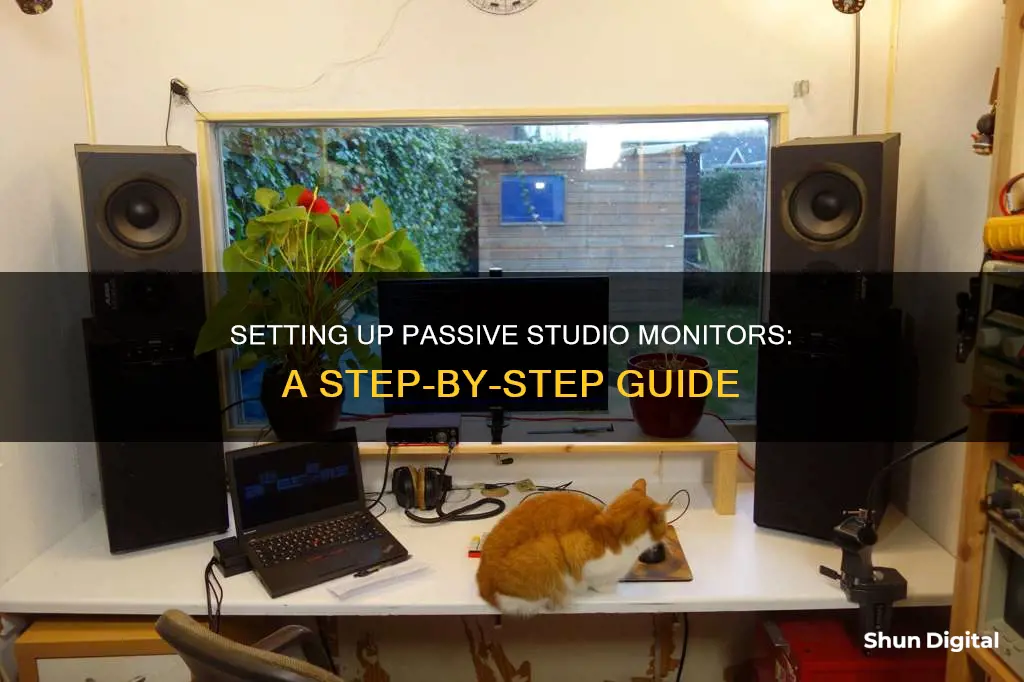
Passive studio monitors are a great option for those who want a customizable setup and aren't afraid of putting in a little extra effort. Unlike active monitors, which have built-in amplifiers, passive monitors require an external amplifier, allowing users to select and upgrade their equipment as desired. This provides the flexibility to tailor the sound system to perfection. However, it also adds complexity and may require more space and potentially higher costs due to the additional equipment. When setting up passive studio monitors, it is crucial to ensure that the amplifier matches the power rating and impedance of the monitors for optimal performance. Additionally, high-quality speaker cables should be used to minimize signal loss and interference.
How to Set Up Passive Studio Monitors
| Characteristics | Values |
|---|---|
| Amplifier | Ensure the amplifier matches the power rating and impedance of your monitors for optimal performance. |
| Speaker Cables | Connect your passive monitors to the amplifier using high-quality speaker cables to minimise signal loss and interference. |
| Audio Interface or Mixer | This device allows you to plug in instruments, microphones, or other audio sources. It converts analog signals to digital for your computer and can also act as a preamp. |
| Balanced Cables | Use balanced cables (TRS or XLR) to connect your audio interface to the amplifier. These cables help to minimise noise and interference, especially over long distances. |
What You'll Learn

Choosing the right cables
When setting up passive studio monitors, choosing the right cables is essential to ensure optimal sound quality and performance. Here are some detailed guidelines for selecting the appropriate cables:
- Speaker Cables: Since passive monitors require an external amplifier, high-quality speaker cables are necessary to connect the monitors to the amplifier. These cables play a vital role in minimising signal loss and reducing interference, ensuring a clear and uninterrupted audio signal transmission.
- Balanced Cables (XLR, TRS): Balanced cables are crucial for maintaining a clean and stable audio signal. They help to minimise noise and interference, especially over long cable runs. XLR and TRS cables are commonly used in professional audio setups and are designed to preserve the integrity of the audio signal.
- Power Cables: While passive monitors do not have built-in amplifiers, the external amplifier you use will require power cables. Ensure that you have the correct power cables to connect the amplifier to a power source, providing it with the necessary electrical supply.
- Other Connections: Depending on your setup, you may need additional cables for connecting instruments, microphones, or other audio sources to your mixer or audio interface. These could include TRS or XLR cables for balanced connections, ensuring optimal sound quality and minimising noise.
- Cable Quality: It is important to invest in high-quality cables to ensure optimal performance and longevity. Cheap cables may introduce unwanted noise, interference, or signal degradation, compromising the overall sound quality of your studio setup.
- Cable Management: Proper cable management is crucial for maintaining a tidy and organised studio space. Use cable ties, sleeves, or wraps to bundle cables together neatly, preventing tangles and reducing the risk of tripping hazards. Clearly label cables to make identification and troubleshooting easier.
By selecting the right cables and ensuring proper connections, you can optimise the performance of your passive studio monitors, resulting in improved sound quality and a more efficient workflow.
Monitoring Internet Usage: Boost Mobile's Data Insights
You may want to see also

Amplifier selection
When selecting an amplifier, it is imperative to ensure that it matches the power rating and impedance of the passive monitors. This compatibility ensures optimal performance and prevents potential damage to the equipment. It is also essential to refer to the user manuals of the monitors and amplifiers to ascertain specific requirements regarding connection types, impedance, and power ratings.
High-quality speaker cables are necessary to connect the passive monitors to the amplifier. These cables minimise signal loss and interference, contributing to the overall sound quality.
The amplifier's role is to amplify the audio signal and drive the passive monitors. It is worth noting that the amplifier's power rating should be adequate to enable the monitors to play at desired volumes without distortion.
Additionally, the amplifier's design and specifications can impact the sound quality and customisation options. Some amplifiers may include bi-amp or tri-amp configurations, allowing for precise control over the power delivered to each driver in the monitor. This level of customisation can be beneficial for fine-tuning the sound to match specific requirements or acoustic environments.
In summary, selecting the right amplifier for passive studio monitors involves ensuring compatibility with the monitors' power rating and impedance, using high-quality cables for connection, and considering the amplifier's specifications and features to achieve the desired sound quality and customisation.
Performance Monitor: Licensing Requirements for Running the Software
You may want to see also

Speaker placement
When setting up passive studio monitors, the placement of the speakers is crucial to achieving the best sound quality. Here are some tips for optimising your speaker placement:
Symmetry
The room you are in will impact the sound you hear. Stereo sound, in particular, can be affected by the shape of the room, with different sounds coming from the left and right speakers. To achieve the best results, place your speakers symmetrically, centred on a single wall, rather than in the corner of a rectangular room. This will ensure any imbalances are uniform across the left and right sides of the stereo field.
Position Along the Short Wall
Position your speakers along the short wall of the room. This will reduce the impact of sonic reflections that travel from the speaker to a nearby wall and back to your ear. As sound travels further, its intensity decreases, so minimising the distance the sound has to travel will result in more accurate sound.
Ear Level
Position the tweeters of your speakers at head height so that your ears are directly in front of the speakers. This will give you the most consistent sound. If your setup does not allow you to raise the speakers high enough, consider using speaker stands to elevate them.
Avoid Reflections from Nearby Hard Surfaces
Acoustically hard surfaces such as windows, drywall, mirrors, and non-absorptive surfaces reflect sound. When the direct sound from the speaker combines with reflected sound, it creates comb filtering, altering the sound. To avoid this, use a flat mirror to detect any reflections. If you can see the speaker reflected, apply absorption to that surface.
Adjust the Monitors
Play music that you know well and that sounds great on other systems, and adjust your speakers until they sound correct. If there is too much bass, move the speakers away from walls and corners. If your speakers have adjustments, tweak these until the sound is optimal.
Transferring Manga Studio 5 to Another Monitor: Easy Steps
You may want to see also

Acoustic treatment
There are some common acoustic problems that you will face in any room. These include:
- Comb filtering
- Flutter echo
- Room modes, standing waves, nodes and anti-nodes
- Excessive decay time
Comb Filtering
When a direct sound is combined with its reflection, a comb filter is created. This is characterised by notches introduced to the frequency response of the resulting sound. The location of the notches within the frequency spectrum is dependent on the delay time between the direct sound and the reflected sound.
Flutter Echo
Flutter echo may occur when a sound reflects back and forth between untreated parallel walls. If the time between reflections is large enough, your ears will perceive these reflections as an echo. This effect is strengthened by the regularity of the echoes.
Room Modes, Standing Waves, Nodes and Anti-Nodes
The sound-pressure level in a room will be different at various positions and will vary based on frequency. This is due to the way sound reflects off boundary surfaces. Certain spots in your room will be more resonant within specific frequency ranges than others; these are called room modes.
Room modes, standing waves, nodes, and anti-nodes are the main culprits responsible for why you have trouble setting the level of your low-end properly. If you’ve set up your mixing position at a standing wave’s node, you’ll hear a lack of bass. If you’ve set it up at an anti-node, you’ll hear an abundance of bass. In either case, the level adjustments you make to compensate will cause your mix to suffer when played back through a different speaker system.
Excessive Decay Time
Imagine what it sounds like when you yell in a gymnasium; the sound has a “tail” that slowly decays. Now imagine yelling in your car with the windows up; the sound is much more “dead”, and the decay time is shorter. Striking a balance between a “live” room and a “dead” room is important and subjective. A “live” room will allow sound to interact with it to some extent before it decays, while a “dead” room will absorb sound almost instantly.
Types of Acoustic Treatment
There are several primary forms of acoustic treatment:
- Absorption
- Reflection/Diffusion
- Decoupling and Isolation
Absorption
Absorbers convert sound into heat. When a sound wave comes into contact with an absorptive material, its energy is reduced. Dense, porous materials work well as absorbers; sound enters through the pores, gets trapped inside, and is converted into heat. Porous absorbers are excellent at absorbing high frequencies, while panel and volume absorbers are more suited for low frequencies.
Reflection/Diffusion
When a sound comes into contact with a reflective material, its energy is redirected. Hard, organic materials like wood do a great job of reflecting sound. Reflectors also tend to be unique in their shape, with jagged designs meant to diffuse the energy of sound waves.
It’s okay for your room to sound like a room, but you should deal with issues that will cause you to make poor mixing decisions. By adding too many absorbers, you may deaden your room to the point of unnaturalness. One workaround is to use reflectors/diffusors in place of some absorbers to keep the room sounding lively, while simultaneously dispersing sound to avoid issues like flutter echo and standing waves.
Decoupling and Isolation
The sound waves your speakers produce are the result of a membrane vibrating back and forth. A speaker’s enclosure can cause playback inaccuracies if it vibrates in addition to the membrane. Two ways of preventing this include decoupling or coupling your speakers with the floor.
Decoupling involves reducing the amplitude of vibrations that pass from your floor to your speakers (and vice versa) by using damping pads or damping feet. Coupling, on the other hand, attempts to join your speakers with your floor using speaker spikes. You’ll only want to use coupling for dense floors made of materials like concrete.
Critical Treatment Zones
There are four problematic areas in your studio that require acoustic treatment:
- The ceiling above your desk and the walls to the left and right
- The corners of your room
- The parallel walls to the rear of your room
- The back wall of your studio
The direct sound from your speakers will arrive at your ears before any of the room’s reflections. You want to create a clear separation between the direct sound and early reflections to reduce comb filtering. A popular method is to use absorbers.
To deal with early reflections from your ceiling, you can suspend a large absorption panel halfway between your listening position and the speakers. To deal with early reflections from the walls, you can use a mirror to find the early reflection point along a side wall. This is where you’ll hang an absorption panel.
Room modes end up in corners, so this is where bass builds up. Placing bass traps in the form of panels or wedges in the corners of your room helps to convert low-end energy into heat.
Exposed parallel walls can cause flutter echo. Installing reflectors/diffusors in this critical zone will scatter the sound and prevent flutter echo.
The back wall of your studio is also a parallel wall to the front wall, so flutter echo is a potential issue. Additionally, standing waves are of particular concern. Having moved your desk around to minimise the effect of standing waves, you can further reduce their adverse effects by applying acoustic treatment to the back wall.
The black foam acoustic panels that you can buy on Amazon are ineffective for mid to low-end frequency absorption. They are not thick or dense enough to provide broadband acoustic treatment. Stapling egg cartons to your walls won’t do much to help with room acoustics, either.
Hanging moving blankets on your walls is another option, but if you’re going to use them, make sure they are thick and have extra padding. The heavier they are, the better. However, moving blankets won’t do much to absorb low-end frequencies.
Building Your Own Acoustic Panels
You can save money by building your own acoustic panels. Two popular materials are Rockwool, a non-fibreglass insulation material, and Owens Corning 703, a fibreglass insulation material. Buying these materials in bulk will drastically reduce the cost.
You may want to see also You may want to see also Passive monitors give you the freedom to customise your setup by choosing your own amplifier, crossover system and other processing. They are also lighter, easier to mount and only require a standard speaker cable. You will need an external amplifier, speaker cables, an audio interface or mixer, and balanced cables. First, connect the outputs of the mixer to the inputs on the amplifier. Then, connect the outputs of the amplifier to the monitor's inputs. Improperly connecting speakers and amplifiers can cause damage. It is important to read the user manual carefully and pay attention to connection types, impedance and power ratings.Replacement Monitor Screens: Where to Buy Them?

EQ settings
Finding Monitor Size: Pixel Count for Display Settings
Frequently asked questions







